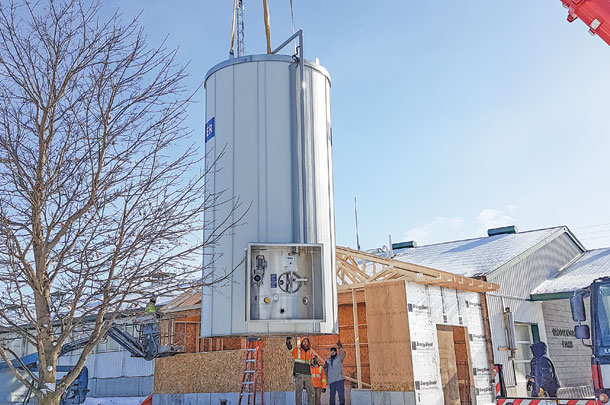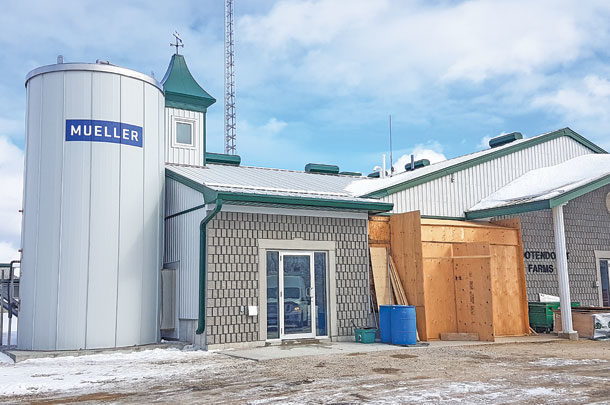In this case, the entire installation took two to three weeks. When ready, a double-pulley crane picked up the tower horizontally and then stood it up on a 12-by-12-foot concrete pad near the milkhouse.
“We set the tower in place, then the contractor finished construction to build around it,” says Harlan Martin, cooling department manager at Norwell Dairy Systems, which is a dealer of Paul Mueller Company products.
The Grootendorsts opted to expand their milkhouse as part of the project, which required additional construction and time for installation compared to a farm that would want to add the tower to an existing building.
Once the building was finished, Martin and his team returned to the farm to install the support equipment for the tower and the instant-chill glycol cooling system.

The farm also upgraded other equipment like vacuum pumps and air compressors, which were installed at the same time.
Overall, this first installation of the milk tower by Norwell Dairy Systems went smoothly.
“There were some learning curves, but we had good support from Paul Mueller Company,” Martin says. “The next one will go even better.”
The Grootendorsts started using the tower at the beginning of March.
“It is functioning every bit as well as we hoped. We are extremely pleased with how it is performing,” Martin says.
The farm is now storing approximately 38,000 litres of milk in the 40,000-litre tower.
In order to conduct the comparative sampling for this pilot project to supply data to Dairy Farmers of Ontario (DFO) and the Ontario Ministry of Agriculture, Food and Rural Affairs (OMAFRA), the milk is pumped to the horizontal tank prior to pick-up.
The milk is picked up every other day. The process starts with samples taken from the milk tower. Then half of the milk is pumped to the 20,000-litre horizontal tank. There, another set of samples are taken, and the milk is pumped to the truck. The process then repeats for the other half of the milk.
The procedure takes about four hours from start to finish but does result in a full truckload of milk. Once the testing phase is complete, it should take much less time when the milk only has to be pumped from the tower into the truck.
Milk samples are being analyzed for composition to affirm the method of sampling from the tower is as accurate as the conventional horizontal tank.
“The results we have seen so far have been lining up almost perfect,” Martin says.
After start-up, the only modification they made to the system was a slightly larger milk pump on the receiver jar to keep up to the head pressure needed to fill the upper half of the tower.
Monitoring the performance of it all is easier with the new Mueller HiPerForm Plus wash panel, which allows for performance data to be accessed remotely.
Martin can help keep an eye on milk temperature, volume, and wash temperature and cycle data without stopping by the farm. It also sends alerts for any equipment failures.
“It will send an alert to us as equipment suppliers as well as the farmer themselves. It’s a real safety net to do a better job. Even when the farmer is not on the farm, the milk in the tower is safe,” he says.
Martin has particularly been watching the milk temperature to see how well the instant-chill system and tower are cooling and storing the milk.
The chiller has three separate cooling units, and the farm is running 1.5 units consistently. With room to spare, it ensures a safety net for cooling milk in case one of the units malfunctions.
“We recommend it with all installs,” Martin says. “The instant chill is a very vital part of the milking system. With the tower, the glycol chiller is the only good way to cool the milk, since the cooling plate configuration on the tower is designed more for maintenance cooling. The extra capacity puts you in position where you are not stranded.”
Since it started operation, the system has been working with milk entering the tower at 3ºC and staying there.
“The milk is never raising temperature after it is in the tower,” he says.
In a conventional system, the milk in storage can raise 7 or 8 degrees then come back down at every milking. With instant chill prior to entering storage, that is not happening.
Without agitating for cooling, the milk in storage only has interval agitation to keep the solids suspended. “We have easily saved 24 hours of constant agitation on a 38,000-litre load,” Martin says. “This feeds into milk quality.”
To see how this impacts the milk, they are also using the sampling system to test for changes in free fatty acids.
“I’m really interested in seeing how instant chilled milk, with much less agitation, affects milk quality,” he says.
Milk samples will continue to be collected and compared for some time until OMAFRA and DFO obtain enough data to determine if the different sampling system for the milk tower is adequate.
Martin says he is grateful for the collaboration of all parties involved to move the project along to the point of operation and sampling. ![]()
PHOTO 1: With the milk tower in place on Grootendorst Farms, it holds two days’ worth of the farm’s milk (38,000 litres) and holds it at a steady 3ºC.
PHOTO 2: A double-pulley crane lifted the tower horizontally from the truck then turned it upright to place on a 12-by-12-foot concrete pad next to the milk house addition at Grootendorst Farms. Photos provided by Harlan Martin.

-
Karen Lee
- Editor
- Progressive Dairy
- Email Karen Lee









